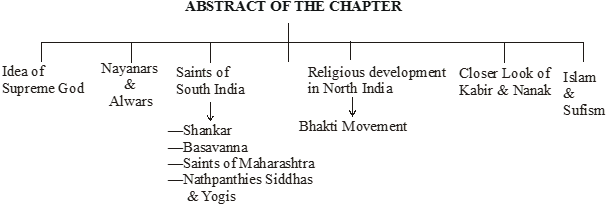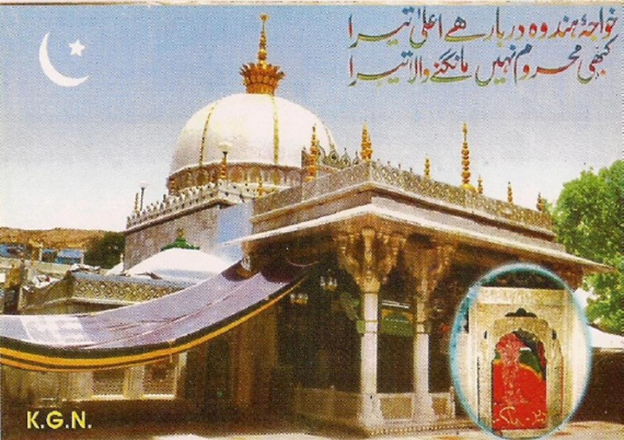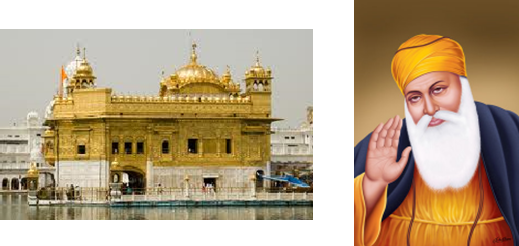- Books Name
- CBSE Class 7 Social Science Book
- Publication
- Param Publication
- Course
- CBSE Class 7
- Subject
- Social Science

* INTRODUCTION
People perform rituals of worship, or singing bhajans, kirtans or qawwalis, or even repeating the name of God in silence, and noticed that some of them are moved to tears. Such intense devotion or love of God is the legacy of various kinds of bhakti and Sufi movements that have evolved since the eighth century.
* The Idea of Supreme God
As people were brought together through the growth of towns, trade and empires, new ideas began to develop.
(i) The idea that all living things pass through countless cycles of birth and rebirth performing good deeds and bad came to be widely accepted.
(ii) The idea that all human beings are not equal even at birth gained ground during this period. The belief that social privileges came from birth in a “noble” family or a “high” caste was the subject of many learned texts.
(iii) Many people were uneasy with such ideas and turned to the teachings of the Buddha or the Jainas according to which it was possible to overcome social differences and break the cycle of rebirth through personal effort.
(iv) Others felt attracted to the idea of a Supreme God who could deliver humans from such bondage if approached with devotion (or bhakti). This idea, advocated in the Bhagavadgita, grew in popularity in the early centuries of the Common Era.
(v) Shiva, Vishnu and Durga as supreme deities came to be worshipped through elaborate rituals.
(vi) At the same time, gods and goddesses worshipped in different areas came to be identified with Shiva, Vishnu or Durga.
(vii) In the process, local myths and legends became a part of the Puranic stories, and methods of worship recommended in the Puranas were introduced into the local cults. Eventually the Puranas also laid down that it was possible for devotees to receive the grace of God regardless of their caste status.
* A New Kind of Bhakti in South India-nayanaras and Alvars
The seventh to ninth centuries saw the emergence of new religious movements, led by the Nayanars (saints devoted to Shiva) and Alvars (saints devoted to Vishnu) who came from all castes including those considered “untouchable” like the Pulaiyar and the Panars.
(i) They were sharply critical of the Buddhists and Jainas and preached ardent love of Shiva or Vishnu as the path to salvation.
(ii) They drew upon the ideals of love and heroism as found in the Sangam literature (the earliest example of Tamil literature, composed during the early centuries of the Common Era) and blended them with the values of bhakti.
(iii) The Nayanaras and Alvars went from place to place composing exquisite poems in praise of the deities enshrined in the villages they visited, and set them to music.
* Nayanars and Alvars
(i) There were 63 Nayanars, who belonged to different caste backgrounds such as potters, “untouchable” workers, peasants, hunters, soldiers, Brahmanas and chiefs. The best known among them were Appar, Sambandar, Sundarar and Manikkavasagar. There are two sets of compilations of their songs - Tevaram and Tiruvacakam.
(ii) There were 12 Alvars, who came from equally divergent backgrounds, the best known being Periyalvar, his daughter Andal, Tondaradippodi Alvar and Nammalvar. Their songs were compiled in the Divya Prabandham.
(iii) Between the tenth and twelfth centuries the Chola and Pandya kings built elaborate temples around many of the shrines visited by the saint-poets, strengthening the links between the bhakti tradition and temple worship. This was also the time when their poems were compiled. Besides, hagiographies or religious biographies of the Alvars and Nayanars were also composed.
* Philosophy and Bhakti
Shankara, one of the most influential philosophers of India, was born in Kerala in the eighth century.
(i) He was an advocate of Advaita or the doctrine of the oneness of the individual soul and the Supreme God which is the Ultimate Reality.
(ii) He taught that Brahman, the only or Ultimate Reality, was formless and without any attributes.
(iii) He considered the world around us to be an illusion or maya, and preached renunciation of the world and adoption of the path of knowledge to understand the true nature of Brahman and attain salvation.
* Ramanuja, born in Tamil Nadu in the eleventh century, was deeply influenced by the Alvars.
(i) According to him the best means of attaining salvation was through intense devotion to Vishnu. Vishnu in His grace helps the devotee to attain the bliss of union with Him.
(ii) Propounded the doctrine of Vishishtadvaita or qualified oneness in that the soul even when united with the Supreme God remained distinct.
(iii) Ramanuja’s doctrine greatly inspired the new strand of bhakti which develped in north India subsequently.
* Basavanna’s Virashaivism
Virashaiva movement initiated by Basavanna and his companions like Allama Prabhu and Akkamahadevi. The movement began in Karnataka in the mid-twelfth century.
(i) The Virashaivas argued strongly for the equality of all human beings and against Brahmanical ideas about caste and the treatment of women.
(ii) They were also against all forms of ritual and idol worship.
* The Saints of Maharashtra
The most important among them were Janeshwar, Namdev, Eknath and Tukaram as well as women like Sakkubai and the family of Chokhamela, who belonged to the “untouchable” Mahar caste. This regional tradition of bhakti focused on the Vitthala (a form of Vishnu) temple in Pandharpur, as well as on the notion of a personal god residing in the hearts of all people.
(i) These saint-poets rejected all forms of ritualism, outward display of piety and social differences based on birth.
(ii) They even rejected the idea of renunciation and preferred to live with their families, earning their livelihood like any other person, while humbly serving fellow human beings in need.
(iii) A new humanist idea emerged as they insisted that bhakti lay in sharing others’ pain. As the famous Gujarati saint Narsi Mehta said, “They are Vaishnavas who understand the pain of others.”
* Nathpanthis, Siddhas and Yogis
A number of religious groups that emerged during this period criticised the ritual and other aspects of conventional religion and these religion and the social order, using simple, logical arguments. Among them were the Nathpanthis, Siddhacharas and Yogis.
(i) They advocated renunciation of the world. To them the path to salvation lay in meditation on the formless Ultimate Reality and the realisation of oneness with it.
(ii) To achieve this they advocated intense training of the mind and body through practices like yogasanas, breathing exercises and meditation.
(iii) These groups became particularly popular among “low” castes. Their criticism of conventional religion created the ground for devotional religion to become a popular force in northern India.
Illustration 1
Who were the important saints of Maharashtra & what were their beliefs ?
Solution
The most important among them were Janeshwar, Namdev, Eknath and Tukaram
(i) These saint-poets rejected all forms of ritualism, outward display of piety and social differences based on birth.
(ii) They even rejected the idea of renunciation and preferred to live with their families, earning their livelihood like any other person, while humbly serving fellow human beings in need.
* Islam and Sufism

Sufis were Muslim mystics. They rejected outward religiosity and emphasised love and devotion to God and compassion towards all fellow human beings.
Islam propagated strict monotheism or submission to one God. It also rejected idol worship and considerably simplified rituals of worship into collective prayers. At the same time Muslim scholars developed a holy law called Shariat.
(i) The Sufis often rejected the elaborate rituals and codes of behaviour demanded by Muslim religious scholars.
(ii) They sought union with God much as a lover seeks his beloved with a disregard for the world.
(iii) Among the great sufis of Central Asia were Gharyali, Rumi and Sadi.
(iv) Sufis believed that heat can be trained to look at the world in a different way.
(v) Sufis developed elaborate methods of praying using Zikr (chanting of a name or sacred formula), Contemplation, Sama (singing), Rags (dancing), discussion of parables, breath control etc. under the guidance of a master or Pir.
(vi) Thus emerged the silsilas, a genealogy of sufi teachers, each following a slightly different method (tariqa) of instruction and ritual practice.
(vii) A large number of sufis from Central Asia settled in Hindustan from the eleventh century onwards.
(viii) Several major sufi centres developed all over the subcontinent at the time of Delhi Sultanate.
(ix) The Chisti silsila was among the most influential orders.
(x) Some of the prominent saints also known as Pirs were:
(a) Khwaja Muinuddin Chisthi of Ajmer.
(b) Qutbuddin Bakhtiar Kaki of Delhi.
(c) Baba Farid of Punjab.
(d) Khwaja Nizamuddin Auliya of Delhi, and
(e) Bandanawaz Gisudaraz of Gulbarga.
(xi) The Sufi masters held assembly in their Khanqahs or Hospices.
(xii) They discuss spritual matters in Khanqahs and sought the blessing of the saints in solving their worldy problems, simply attended the music and dance session.
(xiii) The tomb or Dargarh of Sufi saint became a place of pilgrimage to which thousands of people of all faiths thronged.
(xiv) Jalaluddin Rumi was a great thirteenth century Sufi poet from Iran who wrote in Persian.
* New Religious Developments in North India
The period after the thirteenth century saw a new wave of the bhakti movement in north India. This was an age when Islam, Brahmanical Hinduism, Sufism, various strands of bhakti, and the Nathpanths, Siddhas and Yogis influenced one another.
(i) Some of them like Kabir and Baba Guru Nanak rejected all orthodox religions. Others like Tulsidas and Surdas accepted existing beliefs and practices but wanted to make these accessible to all. Tulsidas conceived of God in the form of Rama. Tulsidas’s composition, the Ramcharitmanas, written in Awadhi (a language used in eastern Uttar Pradesh), is important both as an expression of his devotion and as a literary work. Surdas was an ardent devotee of Krishna. His compositions, compiled in the Sursagara, Surasavali and Sahitya Lahari, express his devotion.
(ii) Also contemporary was Shankaradeva of Assam (Late fifteenth century) who emphasised devotion to Vishnu, and composed poems and plays in Assamese. He began the practice of setting up namghars or houses of recitation and prayer, a practice that continues to date.
(iii) This tradition also included saints like Dadu Dayal, Ravidas and Mirabai. Mirabai became a disciple of Ravidas, a saint from a caste considered “untouchable”. She was devoted to Krishna and composed innumerable bhajans expressing her intense devotion. Her songs also openly challenged the norms of the “upper” castes and became popular with the masses in Rajasthan and Gujarat.
(iv) Ramananda : Ramananda, a follower of Ramanuja, preached in the second half of the 14th century. He was born in Allahabad but spent most of his life in Benares. He worshipped Lord Rama and Sita. He accepted followers from all castes and religions. Among his close disciples were Ravidas, a cobbler, Sena, a barber and Kabir, a weaver. Ramananda was the first to preach in Hindi.
(v) Chaitanya : Chaitanya was a great religious teacher and a devotee of Lord Krishna. He was born in a learned family in Bengal. At the age of 24, he left his house and his house and travelled all over Deccan, Bihar, Orissa and Bengal. He sang devotional songs and danced in the praise of God. People of all castes and religions gathered around him. Chaitanya composed hymns praising Lord Krishna and popularised musical gatherings called kirtans.
* A unique feature of most of the saints is that
(i) Their words were composed in regional languages and could be sung.
(ii) They became immensely popular and were handed down orally from generation to generation.
(iii) Usually the poorest, most deprived communities and women transmitted these songs, often adding their own experiences.
(iv) Thus the songs as we have them today are as much a creation of the saints as of generations of people who sang them. They have become a part of our living popular culture.
* A Closer Look : Kabir
Kabir, who probably lived in the fifteenth-sixteenth centuries, was one of the most influential saints. He was brought up in a family of Muslim Julahas or weavers settled in or near the city of Benares (Varanasi). We have little reliable information about his life.
* A Closer Look : Baba Guru Nanak

(i) Born at Talwandi (Nankana Sahib in Pakistan), he travelled widely before establishing a centre at Kartarpur (Dera Baba Nanak on the river Ravi) A regular worship that consisted of the singing of his own hymns was established there for his followers.
(ii) Before his death in 1539, Guru Nanak appointed one of his followers as his successor. His name was Lehna but he came to be known as Guru Angad. Guru Angad compiled the compositions of Guru Nanak, to which he added his own in a new script known as Gurmukhi. The three successors of Guru angad also wrote under the name of “Nanak”.
* His Philosophies
His greatest work is the Bijak (the Seedling), an idea of the Fundamental one. This collection of Kabir’s poems demonstrates his own universal spirit of oneness.
(i) The most salient feature of his teachings is the denunciation of polytheism, idolatry and casteism.
(ii) He was a true seeker of God, and did his best to break barriers between the Hindus and Muslims.
(iii) Kabir denounced with equal conviction the narrowness of the Hindus and the formalized, orthodox ways of the Muslims.
(iv) He was influenced both by Sufism and the Bhakti cult and tried to bring them closer. He urged human beings to leave worldly pursuits aside and only aim to reach the Supreme Power.
Illustration 1
How did Sufism spread to India? Where did it originate?
Solution
Sufism came to India along with the Muslim rulers. The word Sufi means ‘one who is pure’. In Greek, a sufi is an enlightened person. Sufism was born in Arabia.

 Param Publication
Param Publication
